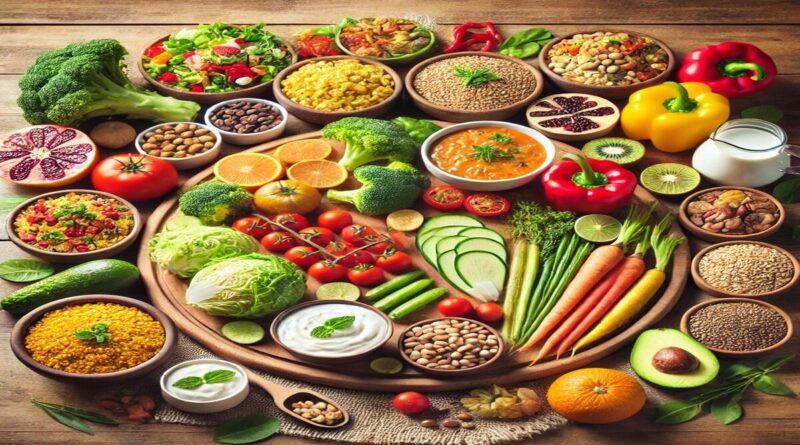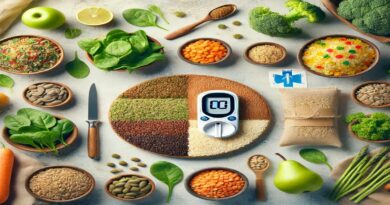Effective and Easy Indian Diet Plan for Weight Loss at Home
Last Updated on 1 year ago by Kashif Rahman
Easy Indian Diet Plan for Weight Loss at Home: Losing weight doesn’t require severe diets or intense Exercise; in fact, such approaches often lead to be exhausted, low motivation, and sometimes, no lasting results. Crash diets and extreme regimens can seem appealing for quick results, but sustainable weight loss relies on balanced habits that you can maintain over time.
Understanding weight loss is about more than just cutting calories; it includes factors like eating nutrient-rich foods, staying active, managing stress, and getting adequate sleep. This Post Easy Indian Diet Plan for Weight Loss at Home, covers all these essentials, offering practical diet tips, an easy-to-follow diet chart, and effective strategies to support your weight loss journey. With the right approach, shedding pounds becomes a gradual and fulfilling process rather than a race.
Key Principles of the Easy Indian Diet Plan for Weight Loss at Home
- Balance Your Macro nutrients: Aim to include carbohydrates, proteins, and healthy fats in each meal.
- Opt for Whole Grains: Replace refined grains with whole options like brown rice, whole-wheat roti, or quinoa.
- Incorporate Plenty of Vegetables: Fill half your plate with non-starchy vegetables for fiber, vitamins, and minerals.
- Stay Hydrated: Drinking water throughout the day can help control hunger and support metabolism.
- Spices for Metabolism: Spices like turmeric, cumin, and ginger not only add flavor but may help improve digestion and metabolism.
Factors Influencing Weight Loss
Easy Indian Diet Plan for Weight Loss at Home: Losing weight and keeping it off requires a blend of healthy habits. Beyond diet and exercise, factors like sleep, stress, and even genetics play key roles in how we shed pounds. Here’s a breakdown of what can impact your weight loss journey:
Diet
An easy Indian diet plan for weight loss at home can be highly effective when it includes whole foods rich in fiber, protein, and low in unhealthy fats. This means opting for fresh fruits, vegetables, legumes, whole grains, and lean proteins, which are nutrient-dense yet low in calories. Avoiding processed foods and sugary snacks helps reduce calorie intake without leaving you feeling deprived.
Exercise
Consistent physical activity is essential for burning calories and building muscle, both of which contribute to weight loss. Find activities you enjoy, whether it’s walking, yoga, or dancing. This way, exercise becomes a sustainable habit, not a chore.
Stress
High stress can lead to emotional eating and cravings, often for comfort foods high in sugar or fat. Techniques like meditation, deep breathing, or even hobbies can help manage stress levels, reducing the urge for “stress-eating.”
Sleep
Getting enough quality sleep supports healthy weight loss by regulating the hormones that control hunger and satiety. When we’re sleep-deprived, levels of ghrelin (the hunger hormone) increase, while leptin (the hormone that signals fullness) decreases. This imbalance can lead to overeating.
Medications
Some medications, including certain antidepressants, can influence weight gain or loss. If you’re concerned, talk to your doctor to explore alternatives or adjustments that may support your weight goals.
Genetics
Your genetic makeup can influence how your body stores and processes fat. While genetics aren’t within your control, understanding them can help you make realistic and effective lifestyle choices.
Age
As we age, our metabolism naturally slows, and our muscle mass may decrease, leading to fewer calories burned at rest. Adapting your diet and activity levels to counter these changes can help.
Hormones
Hormonal imbalances, such as in cortisol, insulin, and thyroid levels, can lead to weight gain. For example, high cortisol (a stress hormone) can increase cravings for unhealthy foods, while insulin resistance can make it harder for your body to process sugar effectively.
Indian Meal Plan for Weight Loss
Morning Routine (6:30 – 7:30 AM)
- Start with Warm Water: Begin the day with a glass of warm water with a squeeze of lemon to kick start digestion.
- Herbal Tea: Optionally, have a cup of green tea, ginger tea, or any herbal tea without added sugar.
Breakfast (8:00 – 9:00 AM)
- Option 1: Poha with vegetables (add carrots, peas, onions, etc.) for fiber and satiety.
- Option 2: Vegetable upma made with rava and assorted veggies.
- Option 3: Oats porridge topped with fruits like apple or banana and a sprinkle of chia seeds.
Focus on including a mix of protein and fiber to keep you full until lunchtime.
Mid-Morning Snack (11:00 AM)
- Fruit Option: Choose one whole fruit, such as an apple, orange, or a few slices of papaya.
- Alternative: A handful of almonds or walnuts for healthy fats and protein.
Lunch (1:00 – 2:00 PM)
- Dal with Brown Rice: Pair with a side of mixed vegetables (such as a stir-fry or salad).
- Vegetable Roti Wrap: Whole-wheat roti with a filling of lightly cooked vegetables and paneer for protein.
- Khichdi: Made with moong dal and a variety of vegetables, seasoned with turmeric and cumin.
Avoid excess oil, and try to use a minimal amount for cooking. Including a salad or a bowl of curd can make the meal more filling.
Evening Snack (4:00 – 5:00 PM)
- Option 1: A small bowl of roasted chana (chickpeas) for protein and fiber.
- Option 2: Vegetable soup (tomato, spinach, or mixed veggies) for a low-calorie option.
Dinner (7:00 – 8:00 PM)
- Grilled Paneer or Tofu Salad: A mix of greens like lettuce, cucumbers, bell peppers, and grilled paneer or tofu.
- Vegetable Soup: Soup made from low-starch vegetables, flavored with ginger, garlic, and minimal salt.
- Light Dal or Vegetable Curry with Roti: Keep portions moderate and pair with a simple salad.
Dinner should be lighter than lunch to aid digestion and prevent late-night cravings.
Post-Dinner Snack (If Needed)
- A cup of warm milk with a pinch of turmeric or a small piece of jiggery can help curb sweet cravings without adding too many calories.
Also Read
- Best Indian Diet for Managing Diabetes Naturally
- 10 Effective Home Remedies for Common Indian Health Issues You Can Try Today
- The best Bluetooth speakers 2024: top portable speakers
- Top 10 Places to Eat in Glacier National Park.
Foods to Include in Weight Loss
- Whole grains: Brown rice, quinoa, oats, and whole-wheat roti.
- Proteins: Lentils (dal), beans, chickpeas, paneer, tofu, and eggs.
- Healthy fats: Almonds, walnuts, chia seeds, and a little olive oil or coconut oil for cooking.
- Low-starch vegetables: Spinach, broccoli, cauliflower, bell peppers, and tomatoes.
- Herbs and spices: Turmeric, cumin, ginger, garlic, and cinnamon for metabolism support.
Foods to avoid in Weight Loss
- Refined grains: White rice, white bread, and maida-based products.
- Sugary items: Sweets, sugary drinks, and high-calorie desserts.
- Fried foods: Samosas, pakoras, and other deep-fried snacks.
- High-fat dairy: Opt for low-fat or skim options when possible.
Elements of a Balanced Diet for Weight Loss
- Protein
- Carbohydrates
- Fiber
- Healthy Fats
- Drinking good amount of water
- Exercise Regularly
- Low Calories
- Interval between Meals
Tips for Successful Weight Loss Journey
- Mindful Eating: Eat slowly and savor each bite. This can help you feel fuller and more satisfied.
- Portion Control: Even healthy foods can lead to weight gain if eaten in excess. Use smaller plates to help control portions.
- Stay Active: Incorporate light exercise daily, such as walking, yoga, or stretching.
- Plan Your Meals: Pre-planning meals can prevent impulsive eating and help you stay on track.
- Get Enough Sleep: Poor sleep can increase hunger and cravings, so aim for 7-8 hours of rest.
Points To Keep in Mind for Success
- Avoid Packed Foods
- Avoid Processed Foods
- Incorporate Healthy Life style
- Limit Screen time
- Adequate sleep
Conclusion
An Easy Indian Diet Plan for Weight Loss at Home can be a sustainable way to shed pounds without compromising on flavor or satisfaction. By choosing whole, nutrient-rich foods and paying attention to portions, you can enjoy the benefits of a balanced, nourishing diet that supports your goals. Remember, the journey to weight loss is not just about restriction but about making choices that you can maintain and enjoy in the long run.
If you like this post-Easy Indian Diet Plan for Weight Loss at Home, please like share &comments

I am Kashif Rahman, a dedicated blogger and content creator with a keen interest in technology, mobiles, computers, internet,and the Entertainment.Enjoys sharing insightful and engaging content to keep his readers informed and inspired





Your blog is a testament to your expertise and dedication to your craft. I’m constantly impressed by the depth of your knowledge and the clarity of your explanations. Keep up the amazing work!
I am not sure where youre getting your info but good topic I needs to spend some time learning much more or understanding more Thanks for magnificent info I was looking for this information for my mission